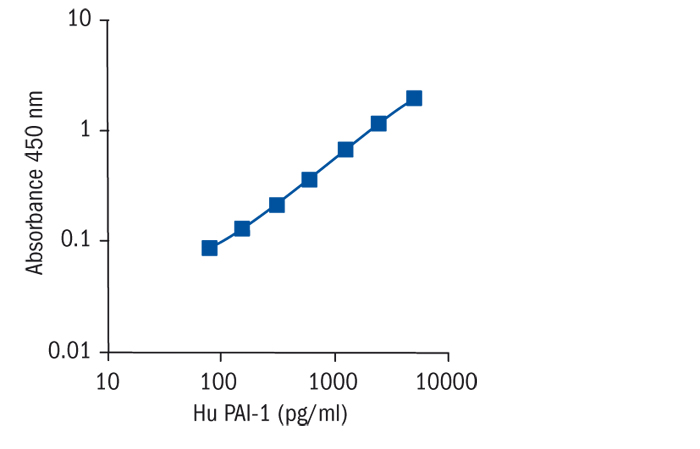Type
Sandwich ELISA, Biotin-labelled antibody
Description
The Human PAI-1 ELISA is an enzyme-linked immunosorbent assay for the quantitative detection of human PAI-1. The Human PAI-1 ELISA is for research use only. Not for use in diagnostic procedures.
Applications
Serum, Plasma-EDTA, Plasma-Heparin, Plasma-Citrate, Cell culture supernatant
Sample Requirements
50 µl (1:50 prediluted)
Shipping
On blue ice packs. Upon receipt, store the product at the temperature recommended below.
Storage/Expiration
Store the complete kit at 2–8°C. Under these conditions, the kit is stable until the expiration date (see label on the box).
Calibration Curve
Calibration Range
78–5000 pg/ml
Limit of Detection
29 pg/ml
Intra-assay (Within-Run)
CV = 4.7%
Inter-assay (Run-to-Run)
CV = 5.0%
Spiking Recovery
serum 72.2%, plasma 58.7%
Dilution Linearity
98,70%
Specificity
The assay detects both natural and recombinant human PAI-1. The interference of circulating factors of the immune systeme was evaluated by spiking these proteins at physiologically relevant concentrations into serum. No cross-reactivity was detected.
Features
- RUO
- calibration range 78-5000 pg/ml
- limit of detection 29 pg/ml
- intra-assay CV = 4.7%
- inter-assay CV = 5.0%
Research topic
Energy metabolism and body weight regulation, Others
Summary
Plasminogen activator inhibitor-1 (PAI-1) is the primary inhibitor of plasminogen activators in plasma, rapidly inactivating both tissue plasminogen activator (t-PA) and urokinase-type plasminogen activator (u-PA). PAI-1 is a single-chain glycoprotein with a molecular weight of 47 kilodaltons. During fibrinolysis, tissue plasminogen activator (tPA) converts the inactive protein plasminogen into plasmin which plays a critical role in fibrinolysis by degrading fibrin and providing localized protease activity in a number of physiological functions. PAI-1 is synthesized in the liver and by endothelial cells, and its synthesis is regulated by several physiologic mediators, including endotoxin, interleukin-1, fibroblast growth factor-2, and lipids. Plasminogen activator inhibitor-1 is an important inhibitor of the fibrinolytic system, so elevated levels could suppress fibrinolysis and result in an increased risk of thrombosis. Increased PAI-1 levels have been shown to be associated with a number of atherosclerotic risk factors, PAI-1 has been shown to act as a prothrombic factor in both arterial and venous thromboembolic disorders.
Find documents for the lot
Example Instructions for Use (RUO)
Example Instructions for Use (RUO)
Safety Information (RUO)
MSDS (RUO)

